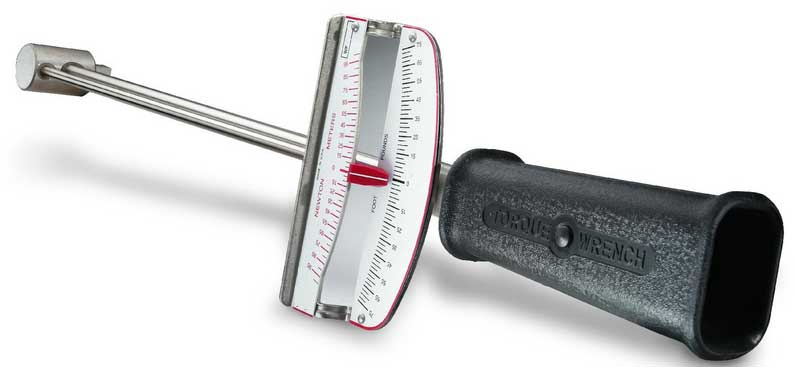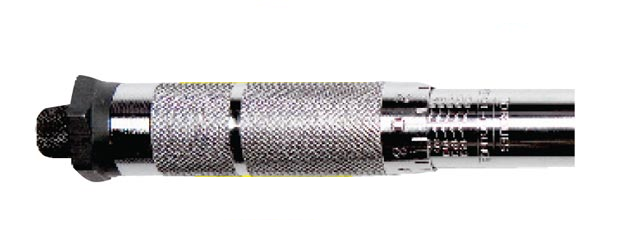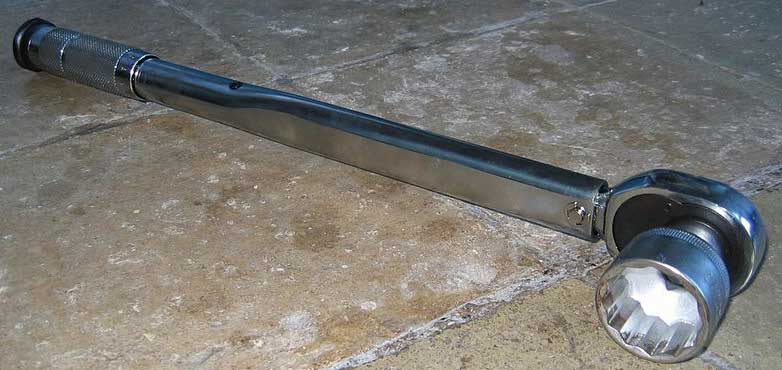Types of Torque Wrenches
- The beam torque wrench
- Click torque wrench
- Electronic torque wrenches
Torque wrenches have been in existence for nearly a century. There are several different types in use today. They range from the simplest, the beam type, to the advanced, programmable electronic torque/angle wrench. Depending on the application, other torque devices are available on the market today: electric, pneumatic, and hydraulic.
Definition of torque:
Torque is rotational force applied around a point; for example, put a foot long wrench on a nut and apply 10 pounds of force to the opposite end. You are now twisting the nut with 10 ft-lbs of force.

Most manufacturers will have torque specifications listed for specific fasteners. Torque wrenches are used to tighten fasteners sufficiently without over-tightening and breaking the fastener. For instance, if you are tightening two pipe flanges together the pipe flanges will have five bolts and nuts connecting them together. A torque wrench will ensure all five bolts and nut are equally tightened.
The beam torque wrench

The simplest form of a torque wrench consists of a long lever arm between the handle and the wrench head, made of a material that will bend elastically under the applied torque. A 2nd smaller bar carrying an indicator is coupled back from the head in parallel to the lever arm. This 2nd arm is under no strain at all and stays straight. A scale is fitted to the handle, and the bending of the main lever causes the scale to move under the indicator. When the desired torque is achieved, the manipulator stops applying force. This model of torque wrench is simple, inherently precise, and affordable.
Click torque wrench


A more advanced technique of presetting torque is with a calibrated click-type torque wrench. At the point where the wanted torque is achieved, the clutch slips making a clicking sound, indicating the wanted torque and preventing supplemental tightening. The more common form utilizes a ball detent and spring, with the spring preloaded by a screw thread, calibrated in torque units of measurement. The ball detent transfers force until the preset torque is achieved, at which point the force exerted by the spring is overwhelmed and the ball “clicks” out of its socket. The advantage of this is better precision and a positive action at the set point. Variations of this design exist for distinct practical applications and distinct torque ranges.
Electronic torque wrenches

With electronic torque wrenches, measurement is made by means of a strain gauge connected to the torsion rod. The signal generated is converted to the required unit of force (N m, ft-lbs, etc.) and shown on the display. At the same time, this generation of torque wrenches can store all the measurements made in an internal memory. This memory can then be easily transferred to a personal computer via the interface (RS232) or printed straight to a printer. A common application of this kind of torque wrench is for in-process documentation or quality assurance purposes.
Using a Torque Wrench
Do not use an un-calibrated torque wrench. The torque wrench should have a sticker stating the calibration date along with the next calibration date. The threads of bolts and nuts should always be clean and dry, unless the specifications state otherwise.
Apply force with a slow, smooth, and uniformed pull at the torque wrench handle.
Do not use the torque wrench on nuts or bolts that have already been completely tightened with a conventional wrench or socket as the desired torque might have already been exceeded. Instead, loosen then re-torque the fastener.
Some maintenance procedures require that we measure how much torque it takes to loosen a fastener. It should be the same as the original torque that was used to tighten the fastener. This is done to assure that the fastener was at the proper torque and was, therefore, taking up its share of the structural load.
When there are several bolts to tighten on a component (especially when they are arranged in a circle) they must be tightened in a specific sequence that is usually specified in the manual. If it isn’t specified, torque the bolts 180 degrees apart.
Tighten each bolt until it just begins to contact the structure.
Tighten each bolt to half its torque value following the proper sequence.
Tighten each bolt to its final torque following the proper sequence.
Re-check the torque on each fastener.
This procedure reduces the strain on the fasteners and allows the parts to be seated correctly and for the loads to be equally distributed.
Sometimes you may need to torque fasteners that are in difficult to get to locations. When this happens, you may need to use an extension attached to the torque wrench. There are two types of extensions: handle extensions and drive end extensions. A handle extension shouldn’t be used with a flexible beam torque wrench since this will cause inaccurate torque readings. Handle extensions can be used on the rigid frame-type torque wrenches because the extensions on these types of torque wrenches do not change the torque applied to the fastener.
However, when you use an extension on the drive end (except when the extension is at 90 degrees), it will change the required torque reading on the wrench. If the maintenance manual instructs you to use an extension, it will also give you the required changes to the torque wrench readings.
To learn more about torque, visit our Industrial Wiki and be sure to check out our Free module of the month, Types and Effects of Shaft Misalignment, both available through the new odesie® site at www.myodesie.com.

